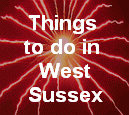Wiston
Wiston Park
One of the great old stately homes of West Sussex, it's a shame that Wiston isn't open to the public on a regular basis like the great houses at Petworth, Parham and Uppark.Wiston House now houses a government conference centre called Wilton Park and runs conferences aimed at making the world a better place by talking about subjects such as poverty, sustainability and human rights amid sumptuous surroundings.
The house was built in 1573-5 by Sir Thomas Shirley on the site of an earlier family pile. Sir Thomas's house was even bigger than the current building - practically a palace, paid for by misappropriated loot.
Much of the money to pay for this lavishness came from graft - Sir Thomas had the good fortune and political nous to be appointed Treasurer-at War at a time when there was a lot of treasure and a lot of war. It was a lucrative post which enabled him to pay for considerably more than a duck house or clock tower without initial opprobrium. In today's terms, Wiston must have cost an unimaginably huge pile of plundered honk.
Eventually his misdemeanors caught up with him however and the Crown took over Wiston.
After the Civil War Robert Fagge bought Wiston and in 1743 his descendant Elizabeth married Charles Goring (the father of the Charles Goring who planted the stripling trees at Chanctonbury Ring), starting the Goring family's long association with this great house.
In the 1830s architect Edward Blore (who finished the designs for Buckingham Palace) remodelled the great house. Fortunately his original idea of leaving the Elizabethan house as a picturesque ruin while he built an entirely new mansion elsewhere in the park was resisted by his wiser client.
Not too much of the original house remains, although the most important part - the facade - is authentic to the 16th century house. Even so, the newer architecture is still special by any standards.
Also largely unchanged is the wonderful setting of Wiston House, underneath the Downs near the spring line, in some of the most beautiful parkland imaginable.
Wiston Church
Right next to Wiston House sits St Mary's Church, Wiston which had reached such a poor condition by Victorian times that it had to be almost completely rebuilt in 1862.The church has some interest fragments which made it through this process.
These include some 14th century Stained glass, and a large brass memorial to Sir John de Braose (Brewys) who died in 1426, 360 years after his ancestor William de Braose had been granted the manor of Wiston by William the Conqueror. There are other monuments to the three great Sussex families (de Braose, Shirley and Goring) who have left their mark on nearly a thousand years of hsitory at Wiston.
Buncton Manor
In the face of such terrific competition from Wiston House, it's no shame to be the second best house in Wiston parish. That honour goes to Buncton Manor House - a lovely 15th century farmhouse with a moat.
Buncton Chapel
All Saints Chapel is a lovely little 11th century chapel built for the convenience of the villagers. The land was granted for the building of a church as far back at the year 791 - over 1200 years ago.Buncton Chapel is one of the most interesting church buildings in Sussex because it hasn't been mucked about by rebuilding, extensions, remodellings and renovations. Definitely worth visiting.

- Amberley Wild Brooks
- Ashington
- Bramber
- Bramber Castle
- Chanctonbury Ring
- Cissbury Ring
- Edburton
- Findon
- Hassocks
- Henfield
- Hurstpierpoint
- Knepp Castle
- Parham
- Poynings
- Shipley
- Storrington
- Sullington
- Washington
- West Chiltington
- Arundel
- Bognor Regis
- Burgess Hill
- Chichester
- Crawley
- East Grinstead
- Haywards Heath
- Horsham
- Littlehampton
- Midhurst
- Petworth
- Shoreham-by-Sea
- Steyning
- Worthing


